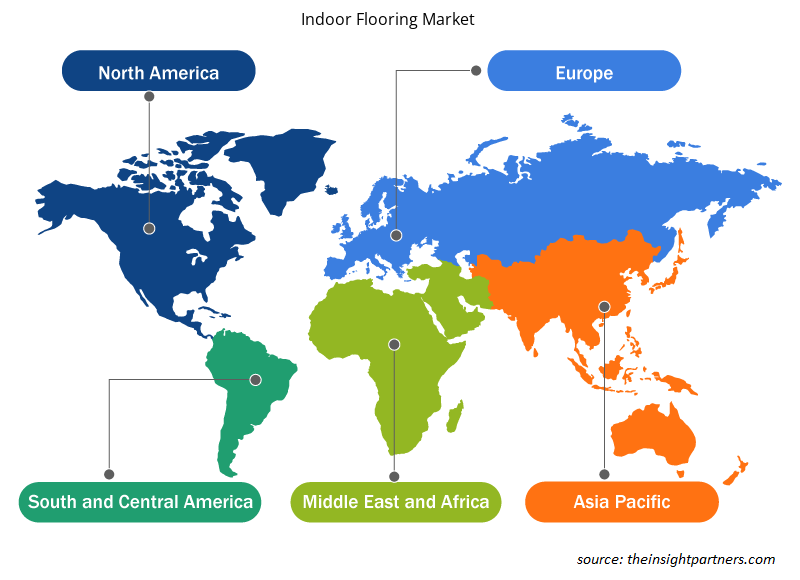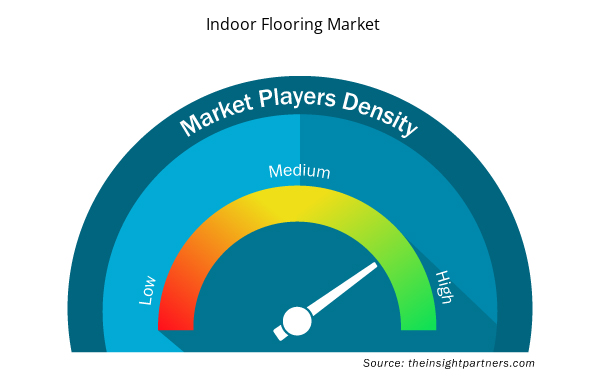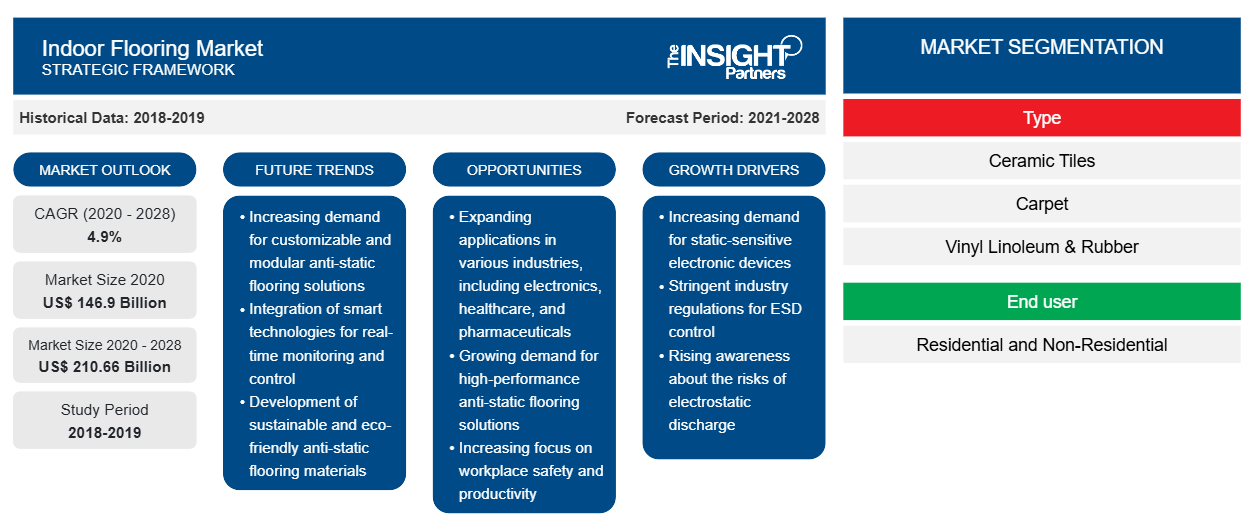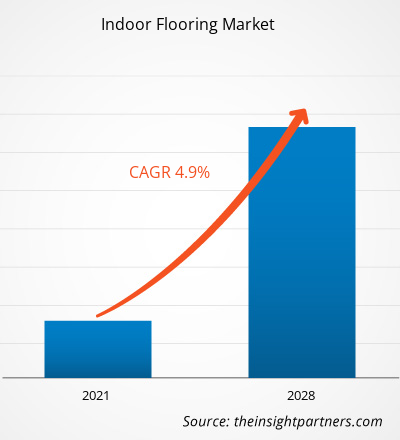[Rapporto di ricerca] Il mercato dei pavimenti per interni è stato valutato a 146,90 miliardi di dollari nel 2020 e si stima che crescerà a un CAGR del 4,9% durante il periodo di previsione dal 2021 al 2028.
In ambienti industriali quali magazzini, hangar per aeroplani, stabilimenti di assemblaggio, officine di verniciatura, carrozzerie e impianti di distribuzione, i pavimenti in calcestruzzo sono soggetti a usura a causa dell'esposizione a sostanze chimiche e oli aggressivi e corrosivi; possono inoltre essere danneggiati da graffi e abrasioni causati da macchinari e attrezzature pesanti come aeroplani e carrelli elevatori.
La rapida industrializzazione e l'istituzione di impianti di produzione e lavorazione nelle economie in via di sviluppo nell'APAC sta guidando la domanda di rivestimenti per pavimenti, e i settori farmaceutico, alimentare e delle bevande e dell'assemblaggio automobilistico sono i principali generatori di domanda. Le multinazionali in Europa e America stanno espandendo le loro operazioni nei paesi in via di sviluppo dell'APAC come Cina e India. Con produttori rinomati che stanno installando le loro strutture operative nei paesi di questa regione, anche la domanda di rivestimenti per pavimenti di qualità industriale sta aumentando. L'aumento della domanda ha incoraggiato i produttori di pavimenti per interni a introdurre prodotti avanzati e generici, guidando così il mercato dei pavimenti per interni
Personalizza questo report in base alle tue esigenze
Riceverai la personalizzazione gratuita di qualsiasi report, comprese parti di questo report, o analisi a livello nazionale, pacchetto dati Excel, oltre a usufruire di grandi offerte e sconti per start-up e università
- Scopri le principali tendenze di mercato in questo rapporto.Questo campione GRATUITO includerà analisi di dati che spaziano dalle tendenze di mercato alle stime e alle previsioni.
Impatto della pandemia di COVID-19 sul mercato dei pavimenti per interni
L'epidemia di COVID-19 ha avuto un impatto significativo sullo sviluppo delle infrastrutture e sull'economia globale. La risposta internazionale alla rapida interruzione dei settori e delle industrie infrastrutturali chiave è in corso. Secondo l'ultimo rapporto sulla situazione dell'Organizzazione mondiale della sanità, Stati Uniti, India, Brasile, Russia, Regno Unito, Francia, Spagna e Italia sono tra i paesi più colpiti dall'epidemia di COVID-19. L'epidemia è iniziata per la prima volta a Wuhan (Cina) nel dicembre 2019 e da allora si è diffusa in tutto il mondo. La crisi del COVID-19 ha colpito le industrie in tutto il mondo. L'economia globale è stata influenzata negativamente nel 2020, e probabilmente continuerà nel 2021. La pandemia ha sconvolto le aziende e i fornitori di pavimenti per interni in tutto il mondo. Gli operatori del mercato hanno subito interruzioni nelle loro operazioni e probabilmente ne affronteranno le conseguenze fino alla metà del 2021. Le chiusure delle fabbriche, i divieti commerciali e i blocchi alle frontiere hanno avuto un impatto negativo sul settore dei pavimenti per interni. D'altro canto, il mercato si aprirà nel 2021, quindi ci si aspetta che acquisisca slancio nel prossimo futuro.
Approfondimenti sul mercato dei pavimenti per interni
Utilizzo crescente di rivestimenti per pavimenti nei complessi sportivi
I sistemi di rivestimento per pavimenti utilizzati in arene sportive al coperto e all'aperto necessitano della giusta combinazione di proprietà quali eccellente elasticità puntuale, resistenza allo scivolamento, elasticità superficiale e rimbalzo. Devono inoltre essere estremamente durevoli, pur mostrando eccellenti caratteristiche ottiche e compatibilità con materiali coloranti e additivi comunemente utilizzati. I rivestimenti per pavimenti in poliuretano ad alte prestazioni conferiscono eccellente elasticità e buona presa alle superfici, consentendo ai giocatori di essere agili e muoversi abilmente sul campo, il che lo rende un materiale preferito per il rivestimento di pavimenti in palestre sportive al coperto; campi da tennis, pallavolo e basket; e palestre di wrestling e ginnastica. La crescente spesa da parte di governi e aziende edili private per la costruzione di complessi e arene sportive ha portato allo sviluppo di numerose strutture sportive in aree urbane e suburbane, che probabilmente genereranno un'elevata domanda di materiali per pavimenti interni specializzati ad alte prestazioni nei prossimi anni.
Approfondimenti di mercato basati sul tipo
In base al tipo, il mercato dei pavimenti per interni è suddiviso in piastrelle di ceramica, moquette, vinile, linoleum e gomma, legno e laminato e altri. Il segmento delle piastrelle di ceramica ha dominato il mercato dei pavimenti per interni. Le piastrelle di ceramica sono ampiamente utilizzate per migliorare i pavimenti di case, stanze di ospedale e bagni. Sono ampiamente disponibili sul mercato. La ceramica è anche nota come porcellana. Le piastrelle di ceramica sono utilizzate anche per pavimenti e pareti. Sono disponibili in un'ampia gamma di varietà in base a texture, motivi e dimensioni. Nei mercati globali e locali, molti operatori offrono diversi tipi di prodotti correlati.
Gli operatori che operano nel mercato dei pavimenti per interni si concentrano su strategie quali fusioni, acquisizioni e iniziative di mercato per mantenere le loro posizioni nel mercato. Di seguito sono elencati alcuni sviluppi da parte degli operatori chiave:
- Nel 2020, secondo fonti di sviluppo economico statali e locali, Shaw Industries Group ha investito 20 milioni di dollari USA per costruire un nuovo spazio a Ringgold. La società prevede di occupare il nuovo spazio a Ringgold, il 1° giugno 2021 o giù di lì.
- Nel 2018, Interface estende la sua portata ai pavimenti ad alte prestazioni con l'acquisizione di Rubber Flooring Company
Approfondimenti regionali sul mercato dei pavimenti per interni
Le tendenze regionali e i fattori che influenzano il mercato dei pavimenti per interni durante il periodo di previsione sono stati ampiamente spiegati dagli analisti di Insight Partners. Questa sezione discute anche i segmenti e la geografia del mercato dei pavimenti per interni in Nord America, Europa, Asia Pacifico, Medio Oriente e Africa e America meridionale e centrale.

- Ottieni i dati specifici regionali per il mercato dei pavimenti per interni
Ambito del rapporto sul mercato dei pavimenti per interni
| Attributo del report | Dettagli |
|---|---|
| Dimensioni del mercato nel 2020 | 146,9 miliardi di dollari USA |
| Dimensioni del mercato entro il 2028 | 210,66 miliardi di dollari USA |
| CAGR globale (2020 - 2028) | 4,9% |
| Dati storici | 2018-2019 |
| Periodo di previsione | 2021-2028 |
| Segmenti coperti | Per tipo
|
| Regioni e Paesi coperti | America del Nord
|
| Leader di mercato e profili aziendali chiave |
|
Densità degli attori del mercato dei pavimenti per interni: comprendere il suo impatto sulle dinamiche aziendali
Il mercato dei pavimenti per interni sta crescendo rapidamente, spinto dalla crescente domanda degli utenti finali dovuta a fattori quali l'evoluzione delle preferenze dei consumatori, i progressi tecnologici e una maggiore consapevolezza dei vantaggi del prodotto. Con l'aumento della domanda, le aziende stanno ampliando le loro offerte, innovando per soddisfare le esigenze dei consumatori e capitalizzando sulle tendenze emergenti, il che alimenta ulteriormente la crescita del mercato.
La densità degli operatori di mercato si riferisce alla distribuzione di aziende o società che operano in un particolare mercato o settore. Indica quanti concorrenti (operatori di mercato) sono presenti in un dato spazio di mercato in relazione alle sue dimensioni o al valore di mercato totale.
Le principali aziende che operano nel mercato dei pavimenti per interni sono:
- Forbo International SA
- Tappetini Inc.
- Targhetta
- Pavimenti Armstrong, Inc.
- Gruppo internazionale Beaulieu
Disclaimer : le aziende elencate sopra non sono classificate secondo un ordine particolare.

- Ottieni una panoramica dei principali attori del mercato dei pavimenti per interni
Il mercato globale dei pavimenti per interni è stato segmentato come segue:
Mercato globale dei pavimenti per interni – per tipo
- Piastrelle in ceramica
- Tappeto
- Vinile Linoleum e Gomma
- Legno e laminato
- Altri
Mercato globale dei pavimenti per interni – per utente finale
- Residenziale
- Non residenziale
Mercato globale dei pavimenti per interni – per area geografica
- America del Nord
- NOI
- Canada
- Messico
- Europa
- Francia
- Germania
- Italia
- Russia
- Regno Unito
- Resto d'Europa
- Asia Pacifico (APAC)
- Cina
- India
- Giappone
- Australia
- Corea del Sud
- Resto dell'APAC
- Medio Oriente e Africa (MEA)
- Arabia Saudita
- Emirati Arabi Uniti
- Sudafrica
- Resto del MEA
- America del Sud e Centrale (TRUFFA)
- Brasile
- Argentina
- Resto della TRUFFA
Profili aziendali
- Forbo International SA
- Tappetini Inc.
- Targhetta
- Pavimenti Armstrong, Inc.
- Gruppo internazionale Beaulieu
- Ecore Internazionale
- Interfaccia, Inc.
- Società Toli
- Azienda
- Gruppo Shaw Industries, Inc.
- Analisi storica (2 anni), anno base, previsione (7 anni) con CAGR
- Analisi PEST e SWOT
- Valore/volume delle dimensioni del mercato - Globale, regionale, nazionale
- Industria e panorama competitivo
- Set di dati Excel



Report Coverage
Revenue forecast, Company Analysis, Industry landscape, Growth factors, and Trends

Segment Covered
This text is related
to segments covered.

Regional Scope
North America, Europe, Asia Pacific, Middle East & Africa, South & Central America

Country Scope
This text is related
to country scope.
Domande frequenti
The indoor flooring market is led by ceramic tiles segment with highest share and is expected to dominate in the forecast period. The ceramic tiles are widely used to enhance the floors of houses, hospital rooms, toilets, and others. It is extensively available in the market. It is also known as porcelain. The ceramic tiles are used for flooring and walls. It is available in a broad range of varieties based on textures, patterns, and sizes. In the global and the local markets, many players offer different types of related products
Rise in number of commercial and residential construction projects. Moreover, surge in product innovations and launches, thereby substantially driving the automated guided vehicles (AGV) market.
Floors coating systems used in indoor and outdoor sports arenas need the right combination of properties such as excellent point elasticity, skid resistance, surface elasticity, and rebound properties. They should also be extremely durable, while displaying excellent optical characteristics and compatibility with commonly used coloring materials and additives. High-performance polyurethane floor coatings impart excellent elasticity and good grip to surfaces while allowing players to be agile and move skillfully on the court, which makes it a preferred material for coating floors in indoor sports halls; tennis, volleyball, and basketball courts; and wrestling and gymnastic halls. The rising expenditure by government and private construction companies in building sports complexes and arenas has led to the development of numerous sports facilities in urban as well as suburban areas, which are likely to generate a high demand for specialized high-performance indoor flooring materials in the coming years.
Trends and growth analysis reports related to Manufacturing and Construction : READ MORE..
The List of Companies - Indoor Flooring Market
- Forbo International SA
- Mats Inc.
- Tarkett
- Armstrong Flooring, Inc.
- Beaulieu International Group
- Ecore International
- Interface, Inc.
- Toli Corporation
- Mohawk Industries, Inc.
- Shaw Industries Group, Inc.
The Insight Partners performs research in 4 major stages: Data Collection & Secondary Research, Primary Research, Data Analysis and Data Triangulation & Final Review.
- Data Collection and Secondary Research:
As a market research and consulting firm operating from a decade, we have published and advised several client across the globe. First step for any study will start with an assessment of currently available data and insights from existing reports. Further, historical and current market information is collected from Investor Presentations, Annual Reports, SEC Filings, etc., and other information related to company’s performance and market positioning are gathered from Paid Databases (Factiva, Hoovers, and Reuters) and various other publications available in public domain.
Several associations trade associates, technical forums, institutes, societies and organization are accessed to gain technical as well as market related insights through their publications such as research papers, blogs and press releases related to the studies are referred to get cues about the market. Further, white papers, journals, magazines, and other news articles published in last 3 years are scrutinized and analyzed to understand the current market trends.
- Primary Research:
The primarily interview analysis comprise of data obtained from industry participants interview and answers to survey questions gathered by in-house primary team.
For primary research, interviews are conducted with industry experts/CEOs/Marketing Managers/VPs/Subject Matter Experts from both demand and supply side to get a 360-degree view of the market. The primary team conducts several interviews based on the complexity of the markets to understand the various market trends and dynamics which makes research more credible and precise.
A typical research interview fulfils the following functions:
- Provides first-hand information on the market size, market trends, growth trends, competitive landscape, and outlook
- Validates and strengthens in-house secondary research findings
- Develops the analysis team’s expertise and market understanding
Primary research involves email interactions and telephone interviews for each market, category, segment, and sub-segment across geographies. The participants who typically take part in such a process include, but are not limited to:
- Industry participants: VPs, business development managers, market intelligence managers and national sales managers
- Outside experts: Valuation experts, research analysts and key opinion leaders specializing in the electronics and semiconductor industry.
Below is the breakup of our primary respondents by company, designation, and region:

Once we receive the confirmation from primary research sources or primary respondents, we finalize the base year market estimation and forecast the data as per the macroeconomic and microeconomic factors assessed during data collection.
- Data Analysis:
Once data is validated through both secondary as well as primary respondents, we finalize the market estimations by hypothesis formulation and factor analysis at regional and country level.
- Macro-Economic Factor Analysis:
We analyse macroeconomic indicators such the gross domestic product (GDP), increase in the demand for goods and services across industries, technological advancement, regional economic growth, governmental policies, the influence of COVID-19, PEST analysis, and other aspects. This analysis aids in setting benchmarks for various nations/regions and approximating market splits. Additionally, the general trend of the aforementioned components aid in determining the market's development possibilities.
- Country Level Data:
Various factors that are especially aligned to the country are taken into account to determine the market size for a certain area and country, including the presence of vendors, such as headquarters and offices, the country's GDP, demand patterns, and industry growth. To comprehend the market dynamics for the nation, a number of growth variables, inhibitors, application areas, and current market trends are researched. The aforementioned elements aid in determining the country's overall market's growth potential.
- Company Profile:
The “Table of Contents” is formulated by listing and analyzing more than 25 - 30 companies operating in the market ecosystem across geographies. However, we profile only 10 companies as a standard practice in our syndicate reports. These 10 companies comprise leading, emerging, and regional players. Nonetheless, our analysis is not restricted to the 10 listed companies, we also analyze other companies present in the market to develop a holistic view and understand the prevailing trends. The “Company Profiles” section in the report covers key facts, business description, products & services, financial information, SWOT analysis, and key developments. The financial information presented is extracted from the annual reports and official documents of the publicly listed companies. Upon collecting the information for the sections of respective companies, we verify them via various primary sources and then compile the data in respective company profiles. The company level information helps us in deriving the base number as well as in forecasting the market size.
- Developing Base Number:
Aggregation of sales statistics (2020-2022) and macro-economic factor, and other secondary and primary research insights are utilized to arrive at base number and related market shares for 2022. The data gaps are identified in this step and relevant market data is analyzed, collected from paid primary interviews or databases. On finalizing the base year market size, forecasts are developed on the basis of macro-economic, industry and market growth factors and company level analysis.
- Data Triangulation and Final Review:
The market findings and base year market size calculations are validated from supply as well as demand side. Demand side validations are based on macro-economic factor analysis and benchmarks for respective regions and countries. In case of supply side validations, revenues of major companies are estimated (in case not available) based on industry benchmark, approximate number of employees, product portfolio, and primary interviews revenues are gathered. Further revenue from target product/service segment is assessed to avoid overshooting of market statistics. In case of heavy deviations between supply and demand side values, all thes steps are repeated to achieve synchronization.
We follow an iterative model, wherein we share our research findings with Subject Matter Experts (SME’s) and Key Opinion Leaders (KOLs) until consensus view of the market is not formulated – this model negates any drastic deviation in the opinions of experts. Only validated and universally acceptable research findings are quoted in our reports.
We have important check points that we use to validate our research findings – which we call – data triangulation, where we validate the information, we generate from secondary sources with primary interviews and then we re-validate with our internal data bases and Subject matter experts. This comprehensive model enables us to deliver high quality, reliable data in shortest possible time.


 Ottieni un campione gratuito per questo repot
Ottieni un campione gratuito per questo repot